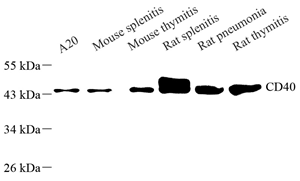| Reactivity: | M,R |
| Applications: | WB |
| Host Species: | Rabbit |
| Clonality: | Polyclonal |
| Full Name: | CD40 rabbit polyclonal antibody |
Gene Name: | Tumor necrosis factor receptor superfamily member 5 |
Synonyms: | CD40, Bp50, CDW40, TNFRSF5, p50, CD40 (protein), CD40 molecule, B cell-associated molecule, TNF receptor superfamily member 5 |
Immunogen: | KLH conjugated Synthetic peptide corresponding to Mouse CD40 |
Isotype: | IgG |
Purity: | Affinity purification |
Predicted MW. | 32 kDa |
Observed MW. | 45 kDa |
Uniprot ID: | P27512 |
Product Usage Information
Applications | Species | Dilution | Positive tissue |
WB | Mouse, Rat | 1: 500-1: 1000 | splenitis, thymitis, pneumonia |
Background
Cluster of differentiation 40, CD40 is a costimulatory protein found on antigen presenting cells and is required for their activation. The binding of CD154 (CD40L) on TH cells to CD40 activates antigen presenting cells and induces a variety of downstream effects. CD40 is is a member of the TNF-receptor superfamily. This receptor has been found to be essential in mediating a broad variety of immune and inflammatory responses including T cell-dependent immunoglobulin class switching, memory B cell development, and germinal center formation. The TNFR-receptor associated factor adaptor proteins TRAF1, TRAF2, TRAF6 and possibly TRAF5 interact with this receptor serve as mediators of the signal transduction. The interaction of this receptor and its ligand is found to be necessary for amyloid-beta-induced microglial activation, and thus is thought to be an early event in Alzheimer disease pathogenesis.
Images
 |
Western blot analysis of CD40 (GB11702) at dilution of 1: 500 |
Storage
| Storage | Store at -20°C for one year. Avoid repeated freeze/ thaw cycles. |
| Storage Buffer | PBS with 0.02% sodium azide, 100 μg/ml BSA and 50% glycerol. |



